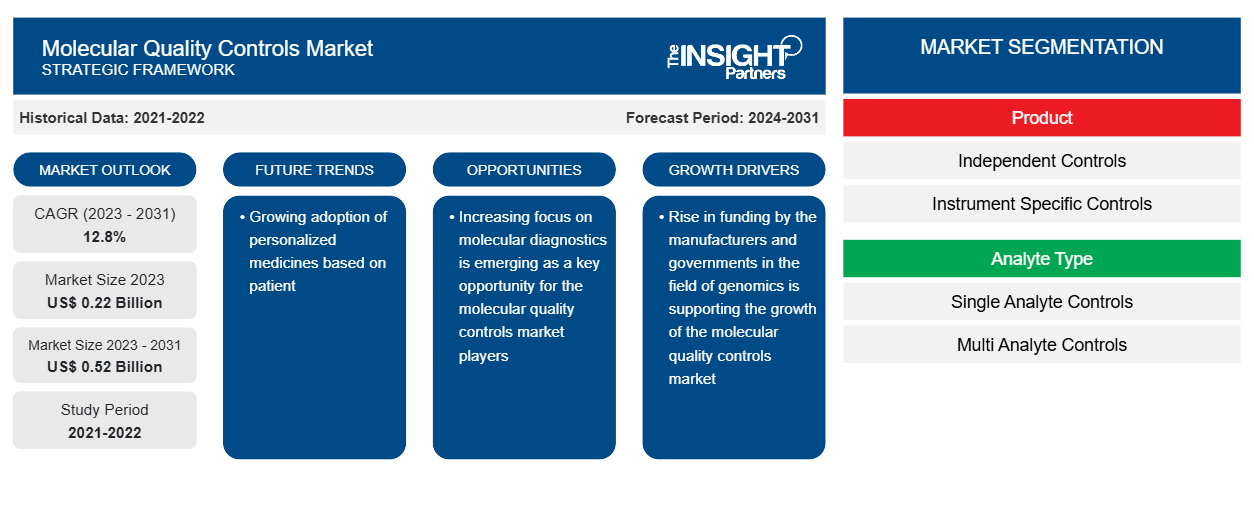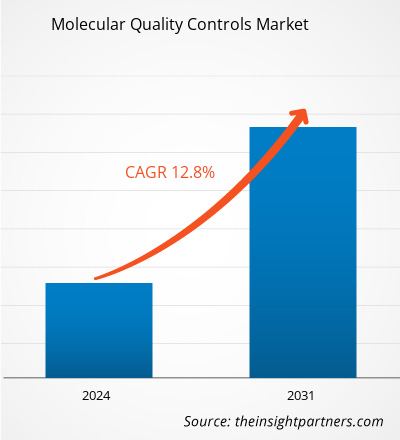分子品質管理市場規模は、2023年の2億2,000万米ドルから2031年には5億2,000万米ドルに達すると予測されています。市場は2023年から2031年の間に12.8%のCAGRを記録すると予想されています。パーソナライズされた医薬品に対する需要の急増は、市場の主要なトレンドであり続けると思われます。
分子品質管理市場分析
ゲノミクスへの資金の増加や遺伝性疾患の罹患率の増加などの要因が市場の成長を後押ししています。さらに、分子診断への注目の高まりは、分子品質管理市場のプレーヤーにとって重要な機会として浮上しています。
分子品質管理市場の概要
ゲノム配列解析は数年前まで研究施設に限定されていました。しかし、現在では臨床診療における標準技術の 1 つとなっています。「ヘルスケアへのゲノム解析の統合」という研究によると、今後数年間でヘルスケア部門は 6,000 万人以上の患者のゲノムデータを生成すると予想されています。ヘルスケア システムにおけるゲノム配列解析の導入拡大は、少なくとも 14 か国で総額 40 億ドルを超える多額の政府投資によって支えられています。英国は、慈善団体と製薬会社による 2 億ドル規模の官民連携の一環として、世界最大のゲノム プロジェクトを発表しました。
要件に合わせてレポートをカスタマイズする
このレポートの一部、国レベルの分析、Excelデータパックなど、あらゆるレポートを無料でカスタマイズできます。また、スタートアップや大学向けのお得なオファーや割引もご利用いただけます。
- このレポートの主要な市場動向を入手してください。この無料サンプルには、市場動向から見積もりや予測に至るまでのデータ分析が含まれます。
分子品質管理市場の推進要因と機会
遺伝性疾患の増加
分子品質管理は結果の解釈を容易にするため、遺伝性疾患の検出に利用されています。21番染色体の全体または一部のコピーが過剰になると、ダウン症候群と呼ばれる遺伝性疾患を引き起こす異常な細胞分裂が起こります。米国疾病管理予防センター (CDC) によると、米国では毎年約6,000人の赤ちゃんがダウン症候群を持って生まれています。その結果、ダウン症候群の出生前検査が全国的に増加しています。
遺伝性乳がんの症例の大半では、BRCA1 (乳がん遺伝子 1) と BRCA2 (乳がん遺伝子 2) の 2 つの遺伝子が変異しています。米国がん協会によると、親から子に受け継がれる欠陥遺伝子は、遺伝性乳がんの発生の 5% ~ 10% を占めています。乳がんの認知度が高まるにつれて、遺伝性乳がんの遺伝子検査はますます普及しつつあります。
分子診断の導入増加
分子診断法は、DNA または RNA 内の特定の配列間の異常を検出するために使用されます。一塩基多型 (SNP)、欠失、再配置、挿入などの異常は、感染症、がん、ウイルス性疾患、性感染症 (STD) など、さまざまな疾患を引き起こします。
インフルエンザの事実と統計レポートによると、2017年から2018年にかけて、インフルエンザによる外来受診は約3,140万件ありました。また、米国の人口の5〜20%が毎年インフルエンザに罹患していると報告されています。さらに、国立がん研究所によると、2020年には米国で約1,806,590件の新たながん症例が診断され、推定死亡者数は606,520人になると予想されています。がん患者数は2024年までに1,900万人に増加すると予想されています。感染症のこのような高い有病率とがんの発生率の増加により、分子診断への大きな関心が高まっています。分子診断は、高い特異性で疾患を診断できるため、精密医療による患者の治療への道をさらに拓きます。
分子品質管理市場レポートのセグメンテーション分析
分子品質管理市場分析の導出に貢献した主要なセグメントは、製品、アプリケーション、およびエンドユーザーです。
- 製品に基づいて、分子品質管理市場は、独立管理と機器固有の管理、分析対象物タイプ(単一分析対象物管理と複数分析対象物管理)に分類されます。独立管理セグメントは、2023年に最も重要な市場シェアを占めました。
- アプリケーションに基づいて、分子品質管理市場は、感染症、腫瘍学、遺伝子検査、その他のアプリケーションに分類されます。感染症セグメントは、2023年に最大の市場シェアを占めました。
- エンドユーザーに基づいて、分子品質管理市場は、臨床検査室、病院、体外診断用医薬品メーカーおよび契約研究機関、学術研究機関、その他のエンドユーザーに分類されます。臨床検査室セグメントは、2023年に最大の市場シェアを占めました。
分子品質管理市場シェアの地域別分析
分子品質管理市場レポートの地理的範囲は、主に北米、アジア太平洋、ヨーロッパ、中東およびアフリカ、南米および中米の 5 つの地域に分かれています。
北米では、米国が最も重要な分子品質管理市場です。がん治療薬、高齢化人口、感染症、その他の治療薬の開発を目的とした製造会社や学術研究機関への投資と資金の増加が、主な推進要因となっています。
NGS に基づく診断は、一般的に、将来、患者の転帰を改善するために治療選択を導くことが期待されています。国立がん研究所によると、米国では 2020 年に推定 1,806,590 件の新規がん症例が診断され、606,520 人がこの病気で亡くなると予想されています。同様に、白血病リンパ腫協会 (LLS) によると、米国では 2020 年に推定 178,520 人が白血病、リンパ腫、または骨髄腫と診断されました。その結果、上記の要因により、予測される期間内に市場の成長が促進されるでしょう。
分子品質管理市場の地域別洞察
予測期間を通じて分子品質管理市場に影響を与える地域的な傾向と要因は、Insight Partners のアナリストによって徹底的に説明されています。このセクションでは、北米、ヨーロッパ、アジア太平洋、中東およびアフリカ、南米および中米にわたる分子品質管理市場のセグメントと地理についても説明します。

- 分子品質管理市場の地域別データを入手
分子品質管理市場レポートの範囲
| レポート属性 | 詳細 |
|---|---|
| 2023年の市場規模 | 2億2千万米ドル |
| 2031年までの市場規模 | 5億2千万米ドル |
| 世界のCAGR(2023年~2031年) | 12.8% |
| 履歴データ | 2021-2022 |
| 予測期間 | 2024-2031 |
| 対象セグメント | 製品別
|
| 対象地域と国 | 北米
|
| 市場リーダーと主要企業プロフィール |
|
分子品質管理市場のプレーヤー密度:ビジネスダイナミクスへの影響を理解する
分子品質管理市場は、消費者の嗜好の変化、技術の進歩、製品の利点に対する認識の高まりなどの要因により、エンドユーザーの需要が高まり、急速に成長しています。需要が高まるにつれて、企業は提供を拡大し、消費者のニーズを満たすために革新し、新たなトレンドを活用し、市場の成長をさらに促進しています。
市場プレーヤー密度とは、特定の市場または業界内で活動している企業または会社の分布を指します。これは、特定の市場スペースに、その市場規模または総市場価値に対してどれだけの競合相手 (市場プレーヤー) が存在するかを示します。
分子品質管理市場で事業を展開している主要企業は次のとおりです。
- サーモフィッシャーサイエンティフィック株式会社
- クノスティックス
- バイオ・ラッド・ラボラトリーズ株式会社
- F. ホフマン・ラ・ロッシュ株式会社
- アボット、クイデルコーポレーション
- メイン モレキュラー コントロールズ社
免責事項:上記の企業は、特定の順序でランク付けされていません。

- 分子品質管理市場のトップキープレーヤーの概要を入手
分子品質管理市場のニュースと最近の動向
分子品質管理市場は、重要な企業出版物、協会データ、データベースを含む一次調査および二次調査後の定性的および定量的データを収集することによって評価されます。分子品質管理市場の動向のいくつかを以下に示します。
- アボットとパーソナリス社は、次世代シーケンシング(NGS)研究で使用するための液体生検コントロールの開発と配布に関する協力契約を締結しました。この協力の目的は、がんの検出と追跡のための液体生検手順の精度と信頼性を高めることです。(出典:アボット、企業ウェブサイト、2024年5月)
- Qiagen 社によると、サイトメガロウイルス、B 型肝炎ウイルス (HBV)、および SARS-CoV-2 用の新しい QuantiTect ウイルス量コントロールが利用可能になりました。これらのコントロールは、臨床現場におけるウイルス感染の正確なモニタリングに対する高まる要求に対応しています。(出典: Qiagen、企業 Web サイト、2024 年 1 月)
分子品質管理市場レポートの対象範囲と成果物
「分子品質管理市場の規模と予測(2021〜2031年)」レポートでは、以下の分野をカバーする市場の詳細な分析を提供しています。
- 対象範囲に含まれるすべての主要市場セグメントについて、世界、地域、国レベルでの分子品質管理の市場規模と予測
- 分子品質管理市場の動向、および推進要因、制約、主要な機会などの市場動向
- 詳細なPEST/ポーターの5つの力とSWOT分析
- 主要な市場動向、世界および地域の枠組み、主要プレーヤー、規制、最近の市場動向を網羅した分子品質管理市場分析。
- 市場集中、ヒートマップ分析、主要プレーヤー、分子品質管理市場の最近の動向を網羅した業界展望と競争分析
- 詳細な企業プロフィール
- 過去2年間の分析、基準年、CAGRによる予測(7年間)
- PEST分析とSWOT分析
- 市場規模価値/数量 - 世界、地域、国
- 業界と競争環境
- Excel データセット



Report Coverage
Revenue forecast, Company Analysis, Industry landscape, Growth factors, and Trends

Segment Covered
This text is related
to segments covered.

Regional Scope
North America, Europe, Asia Pacific, Middle East & Africa, South & Central America

Country Scope
This text is related
to country scope.
よくある質問
North America dominated the molecular quality controls market in 2023
Factors such as growing funds for genomics, declining cost of sequencing procedures, and increasing prevalence of genetic diseases fuel the growth of the market. However, the dearth of skilled professionals hinders the market growth.
The burgeoning demand for personalized Medicine will likely remain a key trend in the market.
THERMO FISHER SCIENTIFIC, INC., Qnostics, BIO-RAD LABORATORIES, INC., F. HOFFMANN LA-ROCHE LTD., Abbott, Quidel Corporation, Maine Molecular Controls, Inc., Zeptometrix Corporation, Microbiologics, and Seracare Life Sciences.
The market is expected to register a CAGR of 12.8% during 2023–2031.
Trends and growth analysis reports related to Life Sciences : READ MORE..
The Insight Partners performs research in 4 major stages: Data Collection & Secondary Research, Primary Research, Data Analysis and Data Triangulation & Final Review.
- Data Collection and Secondary Research:
As a market research and consulting firm operating from a decade, we have published and advised several client across the globe. First step for any study will start with an assessment of currently available data and insights from existing reports. Further, historical and current market information is collected from Investor Presentations, Annual Reports, SEC Filings, etc., and other information related to company’s performance and market positioning are gathered from Paid Databases (Factiva, Hoovers, and Reuters) and various other publications available in public domain.
Several associations trade associates, technical forums, institutes, societies and organization are accessed to gain technical as well as market related insights through their publications such as research papers, blogs and press releases related to the studies are referred to get cues about the market. Further, white papers, journals, magazines, and other news articles published in last 3 years are scrutinized and analyzed to understand the current market trends.
- Primary Research:
The primarily interview analysis comprise of data obtained from industry participants interview and answers to survey questions gathered by in-house primary team.
For primary research, interviews are conducted with industry experts/CEOs/Marketing Managers/VPs/Subject Matter Experts from both demand and supply side to get a 360-degree view of the market. The primary team conducts several interviews based on the complexity of the markets to understand the various market trends and dynamics which makes research more credible and precise.
A typical research interview fulfils the following functions:
- Provides first-hand information on the market size, market trends, growth trends, competitive landscape, and outlook
- Validates and strengthens in-house secondary research findings
- Develops the analysis team’s expertise and market understanding
Primary research involves email interactions and telephone interviews for each market, category, segment, and sub-segment across geographies. The participants who typically take part in such a process include, but are not limited to:
- Industry participants: VPs, business development managers, market intelligence managers and national sales managers
- Outside experts: Valuation experts, research analysts and key opinion leaders specializing in the electronics and semiconductor industry.
Below is the breakup of our primary respondents by company, designation, and region:

Once we receive the confirmation from primary research sources or primary respondents, we finalize the base year market estimation and forecast the data as per the macroeconomic and microeconomic factors assessed during data collection.
- Data Analysis:
Once data is validated through both secondary as well as primary respondents, we finalize the market estimations by hypothesis formulation and factor analysis at regional and country level.
- Macro-Economic Factor Analysis:
We analyse macroeconomic indicators such the gross domestic product (GDP), increase in the demand for goods and services across industries, technological advancement, regional economic growth, governmental policies, the influence of COVID-19, PEST analysis, and other aspects. This analysis aids in setting benchmarks for various nations/regions and approximating market splits. Additionally, the general trend of the aforementioned components aid in determining the market's development possibilities.
- Country Level Data:
Various factors that are especially aligned to the country are taken into account to determine the market size for a certain area and country, including the presence of vendors, such as headquarters and offices, the country's GDP, demand patterns, and industry growth. To comprehend the market dynamics for the nation, a number of growth variables, inhibitors, application areas, and current market trends are researched. The aforementioned elements aid in determining the country's overall market's growth potential.
- Company Profile:
The “Table of Contents” is formulated by listing and analyzing more than 25 - 30 companies operating in the market ecosystem across geographies. However, we profile only 10 companies as a standard practice in our syndicate reports. These 10 companies comprise leading, emerging, and regional players. Nonetheless, our analysis is not restricted to the 10 listed companies, we also analyze other companies present in the market to develop a holistic view and understand the prevailing trends. The “Company Profiles” section in the report covers key facts, business description, products & services, financial information, SWOT analysis, and key developments. The financial information presented is extracted from the annual reports and official documents of the publicly listed companies. Upon collecting the information for the sections of respective companies, we verify them via various primary sources and then compile the data in respective company profiles. The company level information helps us in deriving the base number as well as in forecasting the market size.
- Developing Base Number:
Aggregation of sales statistics (2020-2022) and macro-economic factor, and other secondary and primary research insights are utilized to arrive at base number and related market shares for 2022. The data gaps are identified in this step and relevant market data is analyzed, collected from paid primary interviews or databases. On finalizing the base year market size, forecasts are developed on the basis of macro-economic, industry and market growth factors and company level analysis.
- Data Triangulation and Final Review:
The market findings and base year market size calculations are validated from supply as well as demand side. Demand side validations are based on macro-economic factor analysis and benchmarks for respective regions and countries. In case of supply side validations, revenues of major companies are estimated (in case not available) based on industry benchmark, approximate number of employees, product portfolio, and primary interviews revenues are gathered. Further revenue from target product/service segment is assessed to avoid overshooting of market statistics. In case of heavy deviations between supply and demand side values, all thes steps are repeated to achieve synchronization.
We follow an iterative model, wherein we share our research findings with Subject Matter Experts (SME’s) and Key Opinion Leaders (KOLs) until consensus view of the market is not formulated – this model negates any drastic deviation in the opinions of experts. Only validated and universally acceptable research findings are quoted in our reports.
We have important check points that we use to validate our research findings – which we call – data triangulation, where we validate the information, we generate from secondary sources with primary interviews and then we re-validate with our internal data bases and Subject matter experts. This comprehensive model enables us to deliver high quality, reliable data in shortest possible time.


 このレポートの無料サンプルを入手する
このレポートの無料サンプルを入手する